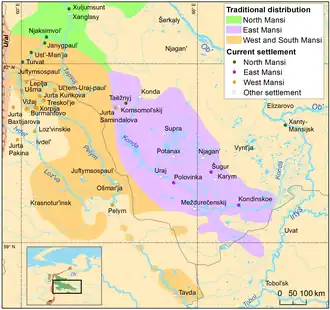Western Mansi language
| Western Mansi | |
|---|---|
| маньсь льӓх, моаньсь лаатых | |
| Pronunciation | [manʲsʲ lʲæx], [moɒ̯nʲsʲ laːtəx] |
| Native to | Russia |
| Region | Sverdlovsk |
| Extinct | late 20th century |
| Dialects |
|
| Language codes | |
| ISO 639-3 | – |
| Glottolog | west2976 |
| ELP | Western Mansi |
 | |
 Western Mansi is classified as Extinct by the UNESCO Atlas of the World's Languages in Danger (2010) | |
Western Mansi is an Uralic language that was described as "probably extinct" in 1988.[3] Although the last speaker is not known, none existed by the end of the 20th century.[4]
The language had strong Russian and Komi influences and considerable dialect differences.[5] Long vowels were diphthongized.
Phonology
Consonants
| Labial | Alveolar | (Alveolo-) palatal |
Velar | ||||
|---|---|---|---|---|---|---|---|
| plain | palatalized | plain | labialized | ||||
| Nasals | /m/ м |
/n/ н |
/nʲ/ нь |
/ŋ/ ӈ |
/ŋʷ/ ӈв | ||
| Stops | /p/ п |
/t/ т |
/tʲ/ ть |
/k/ к |
/kʷ/ кв | ||
| Fricatives | voiceless | /s/ с |
/sʲ/ сь |
/ʃ/ ш |
/x/ х |
/xʷ/ хв | |
| voiced | (β) в |
/ɣ/ г |
|||||
| Semivowels | /j/ й |
/w/ в | |||||
| Laterals | /l/ л |
/lʲ/ ль |
|||||
| Trill | /r/ р |
||||||
- /w/ could also be pronounced as [β].
Vowels
| Front | Central | Back | ||
|---|---|---|---|---|
| unrounded | rounded | |||
| Close | i, iː | y, yː | ɨ | u, uː |
| Close-mid | e, eː | ɘ, ɘː | o, oː | |
| Open-mid | ɔ, ɔː ML | |||
| Open | æ, æː | a, aː PM | (ɑː) ML | |
(PM=Present only in Pelym Mansi | ML=Present only in Middle Lozva Mansi)
- The long /aː/ sound was heard as back [ɑː] in Middle Lozva Mansi.
Diphthongs
Diphthongs were listed as /oɒ̯/ and /eæ̯/.[6]
References
- ^ Rantanen, Timo; Tolvanen, Harri; Roose, Meeli; Ylikoski, Jussi; Vesakoski, Outi (2022-06-08). "Best practices for spatial language data harmonization, sharing and map creation—A case study of Uralic". PLOS ONE. 17 (6): e0269648. Bibcode:2022PLoSO..1769648R. doi:10.1371/journal.pone.0269648. PMC 9176854. PMID 35675367.
- ^ Rantanen, Timo, Vesakoski, Outi, Ylikoski, Jussi, & Tolvanen, Harri. (2021). Geographical database of the Uralic languages (v1.0) [Data set]. Zenodo. https://doi.org/10.5281/zenodo.4784188
- ^ Sinor, Denis (1988-01-01). The Uralic Languages: Description, History and Foreign Influences. BRILL. doi:10.1163/9789004492493_011. ISBN 978-90-04-49249-3.
- ^ Salminen, Tapani (2023). "Demography, endangerment, and revitalization". In Abondolo, Daniel Mario; Valijärvi, Riitta-Liisa (eds.). The Uralic languages. Routledge Language Family (2nd ed.). London New York: Routledge. p. 101-102. ISBN 978-1-138-65084-8.
- ^ Kálmán, Béla (1965). Vogul Chrestomathy. Indiana University Publications. Uralic and Altaic Series. Vol. 46. The Hague: Mouton. pp. 4–5.
- ^ a b c Eichinger, Viktoria (2017). Westmansisch anhand der Textsammlungen von Munkácsi und Kannisto. Universität Wien.
.png)